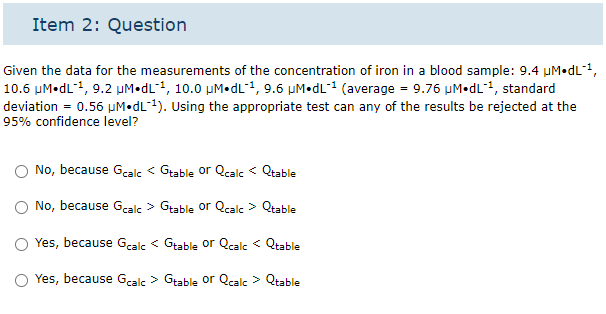Item 2: Question Given the data for the measurements of the concentration of iron in a blood sample: 9.4 µM.dL-¹, 0.6 µM.dL-¹, 9.2 µM.dL¹, 10.0 µM. dL²1, 9.6 µM.dL¹ (average = 9.76 µM.dL¹, standard eviation = 0.56 µM.dL-¹). Using the appropriate test can any of the results be rejected at the 5% confidence level? O No, because Gcalc< Gtable or Qcalc< Qtable No, because Gcalc > Gtable or Qcalc > Qtable O Yes, because Gcalc< Gtable or Qcalc < Qtable
Item 2: Question Given the data for the measurements of the concentration of iron in a blood sample: 9.4 µM.dL-¹, 0.6 µM.dL-¹, 9.2 µM.dL¹, 10.0 µM. dL²1, 9.6 µM.dL¹ (average = 9.76 µM.dL¹, standard eviation = 0.56 µM.dL-¹). Using the appropriate test can any of the results be rejected at the 5% confidence level? O No, because Gcalc< Gtable or Qcalc< Qtable No, because Gcalc > Gtable or Qcalc > Qtable O Yes, because Gcalc< Gtable or Qcalc < Qtable
Chemistry
10th Edition
ISBN:9781305957404
Author:Steven S. Zumdahl, Susan A. Zumdahl, Donald J. DeCoste
Publisher:Steven S. Zumdahl, Susan A. Zumdahl, Donald J. DeCoste
Chapter1: Chemical Foundations
Section: Chapter Questions
Problem 1RQ: Define and explain the differences between the following terms. a. law and theory b. theory and...
Related questions
Question
2. I don't exactly understand what this question is trying to do or ask or how to even solve it. What does the Gcalc, Gtable, Qcalc and Qtable even mean in this context?

Transcribed Image Text:Item 2: Question
Given the data for the measurements of the concentration of iron in a blood sample: 9.4 µM.dL-¹,
10.6 μM.dL-¹, 9.2 µM.dL1, 10.0 μM.dL1, 9.6 µM.dL¹ (average = 9.76 µμM. dL-¹, standard
deviation = 0.56 µM.dL-¹). Using the appropriate test can any of the results be rejected at the
95% confidence level?
No, because Gcalc< Gtable or Qcalc< Qtable
No, because Gcalc > Gtable or Qcalc > Qtable
Yes, because Gcalc< Gtable or Qcalc< Qtable
Yes, because Gcalc > Gtable or Qcalc > Qtable
Expert Solution
This question has been solved!
Explore an expertly crafted, step-by-step solution for a thorough understanding of key concepts.
This is a popular solution!
Trending now
This is a popular solution!
Step by step
Solved in 3 steps with 1 images

Knowledge Booster
Learn more about
Need a deep-dive on the concept behind this application? Look no further. Learn more about this topic, chemistry and related others by exploring similar questions and additional content below.Recommended textbooks for you

Chemistry
Chemistry
ISBN:
9781305957404
Author:
Steven S. Zumdahl, Susan A. Zumdahl, Donald J. DeCoste
Publisher:
Cengage Learning

Chemistry
Chemistry
ISBN:
9781259911156
Author:
Raymond Chang Dr., Jason Overby Professor
Publisher:
McGraw-Hill Education

Principles of Instrumental Analysis
Chemistry
ISBN:
9781305577213
Author:
Douglas A. Skoog, F. James Holler, Stanley R. Crouch
Publisher:
Cengage Learning

Chemistry
Chemistry
ISBN:
9781305957404
Author:
Steven S. Zumdahl, Susan A. Zumdahl, Donald J. DeCoste
Publisher:
Cengage Learning

Chemistry
Chemistry
ISBN:
9781259911156
Author:
Raymond Chang Dr., Jason Overby Professor
Publisher:
McGraw-Hill Education

Principles of Instrumental Analysis
Chemistry
ISBN:
9781305577213
Author:
Douglas A. Skoog, F. James Holler, Stanley R. Crouch
Publisher:
Cengage Learning

Organic Chemistry
Chemistry
ISBN:
9780078021558
Author:
Janice Gorzynski Smith Dr.
Publisher:
McGraw-Hill Education

Chemistry: Principles and Reactions
Chemistry
ISBN:
9781305079373
Author:
William L. Masterton, Cecile N. Hurley
Publisher:
Cengage Learning

Elementary Principles of Chemical Processes, Bind…
Chemistry
ISBN:
9781118431221
Author:
Richard M. Felder, Ronald W. Rousseau, Lisa G. Bullard
Publisher:
WILEY